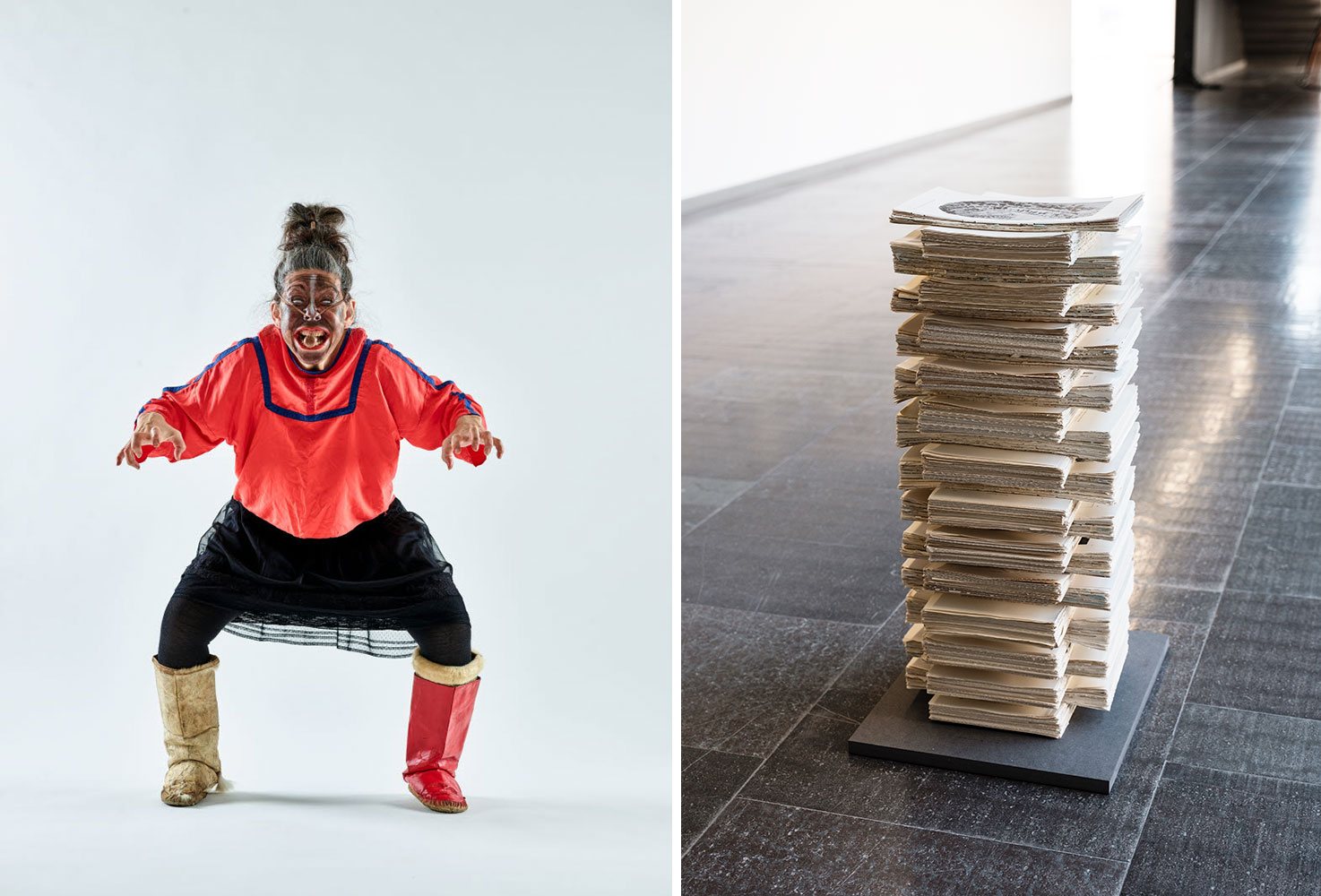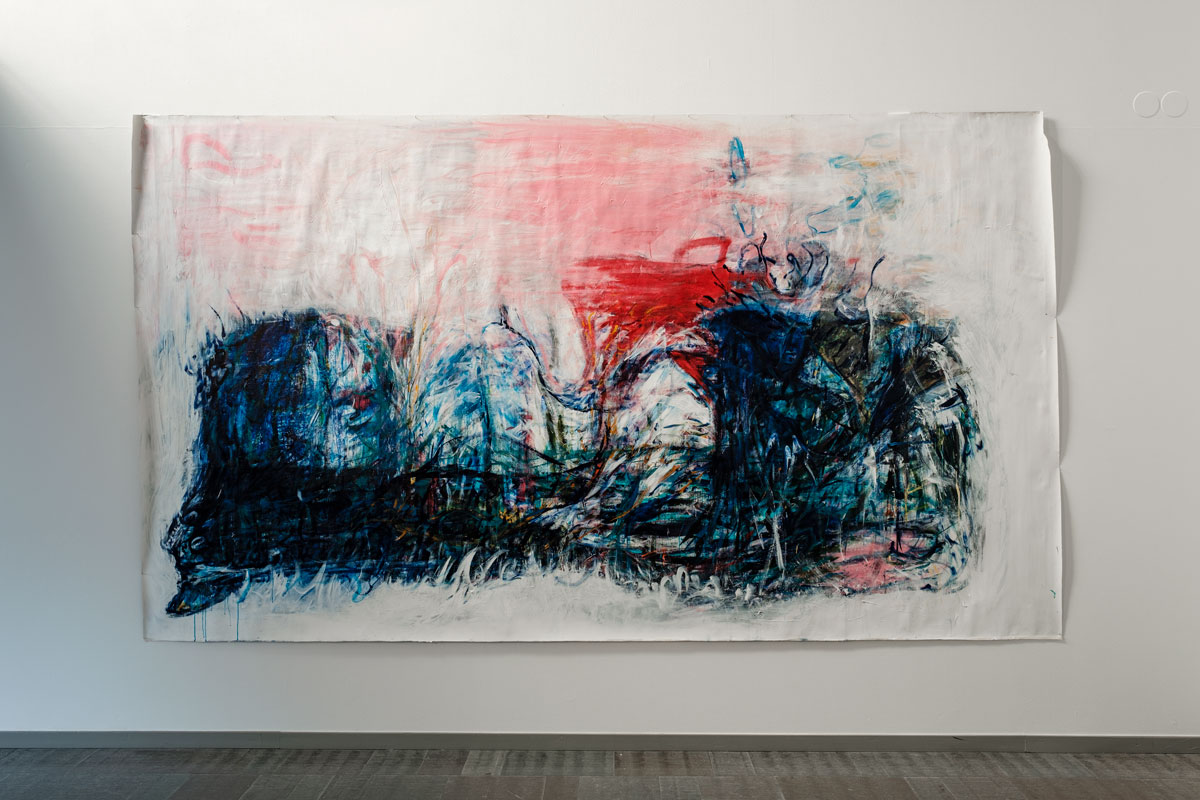ART-PRESENTATION: Worst-Case Scenario.Four Artists from Greenland, Part II
 Lunds konsthall regularly focus on countries or regions that thinks deserve the attention of the interested public. That is certainly true for the exhibition “Worst-Case Scenario: Four Artists from Greenland”. Almost 45 years ago, in the autumn of 1974, Lunds konsthall hosted “Greenlandic Art Today”. Back then “glacial” was a synonym for unchangeable, or changeable only at an extremely slow pace. Today we have been disabused of this complacency, as we observe how fast the Arctic ice sheet is melting away (Part I).
Lunds konsthall regularly focus on countries or regions that thinks deserve the attention of the interested public. That is certainly true for the exhibition “Worst-Case Scenario: Four Artists from Greenland”. Almost 45 years ago, in the autumn of 1974, Lunds konsthall hosted “Greenlandic Art Today”. Back then “glacial” was a synonym for unchangeable, or changeable only at an extremely slow pace. Today we have been disabused of this complacency, as we observe how fast the Arctic ice sheet is melting away (Part I).
By Efi Michalarou
Photo: Lunds konsthall Archive
Of the four artists in the exhibition, Julie Edel Hardenberg is the only one permanently residing in Greenland. Her practice centres on the constant, continuous unmasking of its postcolonial realities as simultaneously tangible and intangible, symbolic and literal (the meaning and use of identity markers such as the Greenlandic and Danish national flags). The survival and revival of precolonial culture become all but indistinguishable in Elisabeth Heilmann Blind’s ongoing reinterpretation of uaajeerneq, the Inuit mask dance tradition. Like so much indigenous knowledge, it is self-evidently ancient without being archaeologically traceable to the period before the early second millennium CE, when the ancestors of today’s Greenlandic Inuits arrived from what is now Canada and Alaska. In her creative reworkings, sometimes manifested in collaboration with Jessie Kleemann, this immaterial heritage is enriched by influences from traditional and postwar Japanese dance and from contemporary ‘western’ performance art. The concept of this exhibition is as hybrid and fluid as the four practices it tries to contain. It is also similarly impure: opportunistically surfing on the crises currently enveloping Greenland, no doubt, and perhaps even ‘intrusively listening’ to the voices of the artists. This was Pia Arke’s biting critique of the Danish art historian Bodil Kaalund, a self-appointed expert on Greenlandic art.
20 important works by Pia Arke illuminate different aspects of her activities in the 15 years between 1988 and 2003. The earliest of them is “Untitled (Blue Square Land Art Project)” (1988, collaboration with Michael Petersen). The two artists painted two 100 m2 ultramarine squares, one on a granite slope outside of Nuuk and one on the ground of an empty urban lot in Copenhagen. In its formal simplicity, the work points out, and tries to bridge, the distance between action and documentation, between painting and photography (although the author of the slides that remain of the project can no longer be identified) and, crucially in the light of Arke’s later preoccupations, between the two countries and cultures that defined her biography and became her artistic material: Greenland and Denmark. In that same year, 1988, she built her own transportable pinhole camera obscura, large enough or herself to fit into, so that she could influence the photographic process with the presence of her own body. Three black-and-white photographs from the series “Nuugaarsuk” (1990), named after a location near the southern tip of Greenland, allow us a glimpse into her travelling creative laboratory. The landscape of mountains and rocks, ocean and ice is the visual constant, remembered from childhood, and it is all the more majestic and forbidding for being captured on film in this ‘primitive’ way (without lens and with long exposures). Yet Arke chooses to sully her sublime vistas with outlines of objects denoting ‘civilisation’ (a teapot, a heavy-duty car) or with her own footprints, as if she had walked over the sky with blood-soaked feet.
Julie Edel Hardenberg’s contribution to the first of its five ‘acts’, at the Living Art Museum in Reykjavik, included 127 photographs from the book “Den stille mangfoldighed: (The Quiet Diversity, 2005, nominated for the Nordic Council’s Literature Price in 2006). In the exhibition are two photographs from this period, ‘Snow” and “View” (both 2006), on which nature (a snowed-over hill) and the city (a housing estate) are glimpsed trough a hand-held mirror. Another work at the Living Art Museum was a walk-in installation with the flags of all the sovereign and self-governing members of the Nordic Council. The eight sheets of artificial silk were hung closely together, as if the entities they symbolise were on equal footing also in real life. Hardenberg had also placed blood bags form a Reykjavik hospital in the installation. The national flag is a recurrent semiotic and visual presence in her work, especially the Danish and Greenlandic flags with their identical colors but far from identical pedigree. Among the exhibited works, Hardenberg’s earliest juxtaposition of these two iconic signs is to be found in “Rigsfællesskabspause” (Commonwealth Pause, 2005), a straightjacket sewn from cotton and featuring the design of the Greenlandic flag on one side and the Danish flag on the other. It inaugurated a string of works casting these flags in different roles and exploiting them for what they were always meant to be: easy-to-read illustrations of ideology, easy-to-use tools of indoctrination. “Ingutsigaq/Unravelling (Trauma)” (2017) is a knitted Danish flag that has started to unravel at the bottom, where the yarns are collected into a ball. “Ineriartorneq/Progress” (2017) shows a knitted Danish flag in the process of being unravelled and reconstituted as a Greenlandic flag, each in its own black wooden frame.
In 2003–12, Elisabeth Heilmann Blind was steadily employed by Giron Sámi Teather, the Sami theatre company in Kiruna, Sweden, where she took part in multiple productions and was entrusted with many practical and organisational tasks. She has also actively helped shape Sami cultural policy, not least as a member of the Cultural Affairs Committee of Sámiráđđi (The Sami Council). Before and after her employment in Kiruna she has, like most modern dancers, worked as a freelancer, and also as a dance and theatre producer. In recent years Greenlandic mask dance has been her core artistic interest and activity. She has often given solo performances lasting about half an hour, of which the first 15 minutes are dedicated to the transformation of the face into a mask in front of the audience. While she speaks about the historical significance and continued meaning of the mask dance, she deforms her face by inserting a wooden stick (shaped like a bone) in her mouth and tying up her nose with a leather strap. In contemporary uaajeerneq the makeup, originally just soot, has become the symbolic triad black (the Polar night, magic, the unknown), red (blood, life, love) and white (ice, purity, the ancestors and their bones). For the exhibition Heilmann Blind has created, in close collaboration with the photographer Hans-Olof Utsi, “Meqqu – Angalasoq” (Meqqu – The Wanderer, 2021), a series of 24 images and six text posters showing her in different costume and makeup, captured in the middle of movements and expressions belonging to her reinterpretation of the mask dance and communicating her view of it as contemporary hybrid art form with global ambitions, open to influences from and reflections on the whole world. There are some close-ups of her face, but usually she appears in full figure, in poses that are alternatively provocative and grotesque, and stylised in ways that bring to mind both Japanese anime and German Tanztheater.
In the exhibition are represented some of Jessie Kleemann’s performances as a wall installation combining photographs and short project descriptions. Although the works are durational and incorporate both movement and sound, Lunds konsthall has chosen this mode of presentation over video. Her performances are characterised by intense bodily presence, mastery of facial expression and refined use of costume and props (and nudity). It is very difficult to credibly capture such lived experiences on video. A skillful photographer can achieve more in the same situation. Kleemann’s performance art stages the contradictory sensations of shock and expectations that present themselves when an elegant, sophisticated woman – in white, black or red, in high-heeself a part of.
Participating Artists: Pia Arke, Julie Edel Hardenberg, Elisabeth Heilmann Blind, Jessie Kleemann
Photo: Pia Arke May only be touched with the thumb and little finger, 1999/2010, Paper, Pia Arke’s estate / Søren Arke Petersen, Copenhagen
Info: Curators: Åsa Nacking, Paula Luduşan Gibe and Anders Kreuger, Lunds konsthall, Mårtenstorget 3, Lund, Duration: 6/3-30/5/2021, Days & Hours: Tue-Wed, Fri & Sun 12:00-17:00, Thu 12:00-20:00, Sat 10;00-17:00, https://lundskonsthall.se


Right: Pia Arke, Self-portrait, 1992, Photograph, Pia Arke’s estate / Søren Arke Petersen, Copenhagen


Right: Pia Arke, May only be touched with the thumb and little finger, 1999/2010, Paper, Pia Arke’s estate / Søren Arke Petersen, Copenhagen


